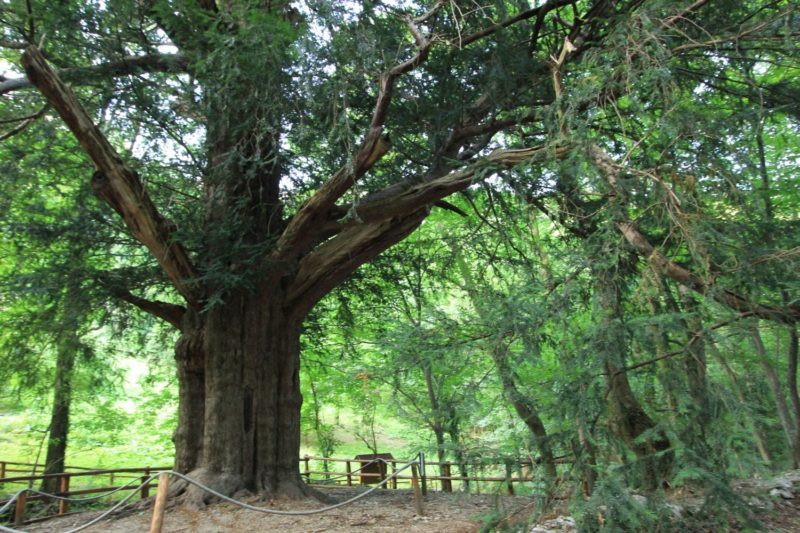
The Yew of Fonte Avellana
This post is also available in:
 Italiano (Italian)
Italiano (Italian)
Taxus baccata (Taxaceae)
In the valley of Mount Catria, in the heart of the Apennines, there’s the monastery of Forte Avellana whose construction began more than a thousand years ago, in 970. The hermitage is surrounded by a mysterious forest of ashes, maples and turkey oaks: right there, according to popular legends, there’s a 500-years old tree (some say 1000-years old): the second largest and longest-lived yew in Italy.
This magnificent monumental tree has a circumference of about 15.6 ft m and a height of 49.2 ft; its branches strive to reach the light in the midst of the foliage all around the tree.
The age of this centuries-old yew is very difficult to estimate but it must have had a close encounter with Dante Alighieri who mentioned this very place, the hermitage and the forest in his famous “Divine Comedy” (21st Canto).
Due to the continuous search for light during the vegetative season and the heavy snowfalls in the colder months, 70% of the largest branches are broken or dry and if nothing is done quickly, the situation will definitely worsen; water could infiltrate the wood and fungal infections could lead to severe damage of the plant. For these reasons, this yew is desperately in need of proper care.
How to get there:
From the municipality of Serra Sant’Abbondio (PU), visitors can reach the monastery of Fonte Avellana and its wood.
Botanical Card:
This species is usually found as a polycormic evergreen shrub. It is most abundant in Europe and Asia, but it also grows in some parts of North Africa.
Yews grow along the temperate mountain belt where winters are snowy, but not too cold, while summers are usually warm. It’s a sciophilous species that thrives in shade, prefers calcareous soils and never grows alone in a forest, as it’s usually found among beeches, maples and conifers at heights between 984ft and 5.250 ft.
This species is toxic, as seeds and leaves contain taxine, an extremely poisonous alkaloid.
Only fruits and fleshy arils are edible and highly appreciated by birds.
Due to its toxicity and difficulty of dosage, any potential pharmaceutical use would not be feasible.
The wood is used for cabinetry, thanks to its acclaimed features: elasticity, toughness, heaviness and hardness.
Photo source: https://homoradixnew.wordpress.com/2015/07/17/gli-spiriti-cantano-e-danzano-sotto-il-tasso-di-fonte-avellana/
This post is also available in:
 Italiano (Italian)
Italiano (Italian)
Contatti
61040 Serra Sant'Abbondio(PU)
